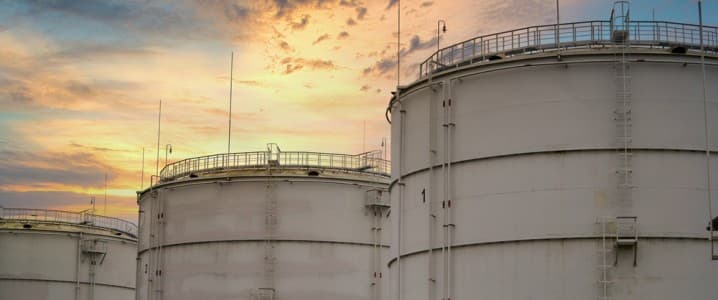Business
China Expands Oil Storage Capacity with 11 New Sites by 2025

China is set to enhance its oil storage infrastructure by constructing a total of 11 new sites over the next two years. This initiative aims to capitalize on the current low crude prices, allowing the nation to stockpile substantial reserves. According to a report from Reuters, the combined storage capacity of these new sites will reach approximately 169 million barrels, enough to cover about two weeks of the country’s crude oil imports.
The planned expansion comes as China has been purchasing crude oil at a rate that exceeds its consumption and export capabilities. This trend has been ongoing for several months, driven by favorable pricing and discounts on sanctioned oil sourced from Russia and Iran. While China does not publicly disclose its inventory figures, analysts estimate stock levels based on data regarding imports and refinery operations.
Stockpiling Trends and Future Projections
In August, China was reportedly stockpiling crude oil at a rate of 1 million barrels daily. For the year to date, this average rate has hovered around 990,000 barrels daily. Projections from Goldman Sachs, particularly from analyst Daan Struyven, suggest that this rate may decrease to approximately 500,000 barrels daily over the next year.
Despite China’s aggressive inventory accumulation, the outlook for the oil market remains cautious. Many commodity analysts anticipate that the market may shift towards oversupply by the end of this year or in 2026. This potential oversupply could lead to lower prices, with some forecasts indicating that Brent crude could fall to as low as $50 per barrel or even dip below that threshold.
According to Goldman Sachs, the projected supply overhang could reach around 1.9 million barrels daily. The International Energy Agency has suggested that this overhang might escalate to a record of 3 million barrels daily. Analysts attribute this potential oversupply to several factors, including robust production from the U.S. shale sector, which, despite experiencing slower growth, continues to contribute significantly to global supply.
In addition to U.S. production, sluggish demand growth and increased output from OPEC+—despite falling short of established targets—are contributing to the anticipated oversupply. As the global oil market evolves, China’s strategy to build new storage facilities underscores its proactive approach to securing energy resources amid fluctuating market conditions.
-

 Education3 months ago
Education3 months agoBrandon University’s Failed $5 Million Project Sparks Oversight Review
-

 Science4 months ago
Science4 months agoMicrosoft Confirms U.S. Law Overrules Canadian Data Sovereignty
-

 Lifestyle3 months ago
Lifestyle3 months agoWinnipeg Celebrates Culinary Creativity During Le Burger Week 2025
-

 Health4 months ago
Health4 months agoMontreal’s Groupe Marcelle Leads Canadian Cosmetic Industry Growth
-

 Science4 months ago
Science4 months agoTech Innovator Amandipp Singh Transforms Hiring for Disabled
-

 Technology3 months ago
Technology3 months agoDragon Ball: Sparking! Zero Launching on Switch and Switch 2 This November
-

 Education3 months ago
Education3 months agoRed River College Launches New Programs to Address Industry Needs
-

 Technology4 months ago
Technology4 months agoGoogle Pixel 10 Pro Fold Specs Unveiled Ahead of Launch
-

 Business3 months ago
Business3 months agoRocket Lab Reports Strong Q2 2025 Revenue Growth and Future Plans
-

 Technology2 months ago
Technology2 months agoDiscord Faces Serious Security Breach Affecting Millions
-

 Education3 months ago
Education3 months agoAlberta Teachers’ Strike: Potential Impacts on Students and Families
-

 Science3 months ago
Science3 months agoChina’s Wukong Spacesuit Sets New Standard for AI in Space
-

 Education3 months ago
Education3 months agoNew SĆIȺNEW̱ SṮEȽIṮḴEȽ Elementary Opens in Langford for 2025/2026 Year
-

 Technology4 months ago
Technology4 months agoWorld of Warcraft Players Buzz Over 19-Quest Bee Challenge
-

 Business4 months ago
Business4 months agoNew Estimates Reveal ChatGPT-5 Energy Use Could Soar
-

 Business3 months ago
Business3 months agoDawson City Residents Rally Around Buy Canadian Movement
-

 Technology2 months ago
Technology2 months agoHuawei MatePad 12X Redefines Tablet Experience for Professionals
-

 Business3 months ago
Business3 months agoBNA Brewing to Open New Bowling Alley in Downtown Penticton
-

 Technology4 months ago
Technology4 months agoFuture Entertainment Launches DDoD with Gameplay Trailer Showcase
-

 Technology4 months ago
Technology4 months agoGlobal Launch of Ragnarok M: Classic Set for September 3, 2025
-

 Technology4 months ago
Technology4 months agoInnovative 140W GaN Travel Adapter Combines Power and Convenience
-

 Science4 months ago
Science4 months agoXi Labs Innovates with New AI Operating System Set for 2025 Launch
-

 Technology4 months ago
Technology4 months agoNew IDR01 Smart Ring Offers Advanced Sports Tracking for $169
-

 Top Stories2 months ago
Top Stories2 months agoBlue Jays Shift José Berríos to Bullpen Ahead of Playoffs










